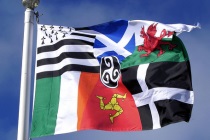Manx National Heritage: Swift And Refrshingly Explicit Reply
NEWS FROM THE CELTIC LEAGUE
Our query about the removal of antiquities to other institutions prior to the establishment of the Manx Museum in 1922 has brought a swift and refreshingly explicit (interim) response from Museum Director Edmund Southworth (picture).
We had asked about an item removed at Treasure Trove in the 19th Century and asked if this and other items were subsequently recovered.
We had assumed that the practice would have ceased in 1922 but as Mr Southworth points out ‘the position is actually worse’ than we had suspected. The law in relation to Treasure Trove in fact did not change until 1970 (when a series of constitutional changes occurred).
Mr Southworth says (as far as he is aware) there has been no audit on such items as may have been removed.
His (interim) response is set out in full below:
“Dear Mr Moffatt,
This email is simply to acknowledge your letter about antiquities from the Isle of Man. My curator of archaeology is on leave at the moment and I’ll need to check some things with her before I respond in detail.
You raise some interesting issues. The position is actually worse in some ways than you suggest. Whilst the Manx Museum had premises from 1922 onward – it was not until the 1970’s that the pre-emptive position of the British Museum over Treasure Trove was altered to allow the Manx Museum to acquire such items. Of course Treasure Trove only applies to particular gold and silver items and because these are high profile finds the records tend to be quite good. As far as I am aware it has never been felt necessary to hold an audit.
Of course many museums across the world legitimately hold things that either originated from the Island or are associated with it. With the advent of computerised databases and online access it is a great deal easier to find things. Websites such as www.culturegrid.org.uk allow us to search across many collections and trace things that relate to the Island. There is an argument for collecting such information into one place.
MNH meets international standards for the care and preservation of collections. This makes it easy to borrow material for exhibition. We work closely with the British Museum and other UK museums and our priority in recent years has been to seek loans as and when we need them rather than repatriating material. For example the first fossilised Great Deer found on the Island was presented by the Duke of Athol to the forerunner of the National Museum in Scotland. This inspired local antiquarians to look for another skeleton – which has been on display on the Island since the end of the 19th century. Would we need two?
I’ll be in touch again in due course.
With best wishes,
Edmund Southworth
BA, M Phil, AMA, FSA, MIoD
Director
Manx National Heritage
Eiraght Ashoonagh Vannin”
The Celtic League is grateful to Mr Southworth for responding so promptly and directly.
BERNARD MOFFATT
Issued by: The Celtic News
13/10/15
THE CELTIC LEAGUE INFORMATION SERVICE.
The Celtic League established in 1961 has branches in the six Celtic Countries. It promotes cooperation between the countries and campaigns on a range of political, cultural and environmental matters. It highlights human rights abuse, military activity and socio-economic issues
- Alastair Kneale's blog
- Log in to post comments







